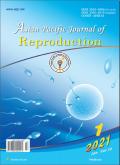健康大鼠和链脲佐菌素诱导的糖尿病大鼠在用鲁伊博(Asparatus linearis)、蜜树(Cyclopia intermedia)和须兰(Lessertia frutescens)治疗后睾丸和附睾尾部的描述性组织形态学评估
IF 0.6
Q4 REPRODUCTIVE BIOLOGY
引用次数: 2
摘要
目的:评价鲁伊波斯(Aspalathus linearis)、蜜丛(Cyclopia intermedia)和芒草(Lessertia frutescens)分别治疗健康大鼠和糖尿病大鼠后睾丸和附睾尾的变化。方法:90只雄性Wistar大鼠随机分为9组,每组10只。50只大鼠随机接受自来水、0.1 M柠檬酸缓冲液、2.0%发酵路易波士、4.0%发酵蜂蜜和0.2%未发酵的芒草。采用45 mg/kg单次腹腔注射链脲佐菌素(STZ)诱导40只大鼠糖尿病。糖尿病大鼠随机接受自来水、2.0%发酵路易波士、4.0%发酵蜂蜜和0.2%未发酵的瑟兰。诱导7周后处死大鼠。采集血液进行激素检测,取睾丸和尾侧附睾进行组织形态学评估。结果:糖尿病大鼠经2.0%发酵路易波士波士处理后,空腹血糖(FPG)较对照组显著升高(P=0.002),较糖尿病对照组降低3.6% (P < 0.05)。与糖尿病对照组相比,蜂蜜和芒草治疗的糖尿病大鼠FPG分别下降23.6%和15.4% (P < 0.05)。与对照组相比,糖尿病对照组大鼠组织学正常的精管百分比显著降低(P=0.049)。与糖尿病对照组相比,服用路易波士、蜂蜜灌木或sutherlandia的糖尿病大鼠的正常精管百分比分别上升了21.0%、14.0%和5.4%。输注对照组(路易波士、蜂窝蜂和刺兰)精子小管正常,附睾腔内存在精子,整体结构正常。糖尿病对照组的睾丸和附睾形态均发生改变,但路易波士、蜂蜜灌木和萨瑟兰可轻度改善这种破坏。结论:2.0%发酵路易波士、4.0%发酵蜂窝蜜和0.2%未发酵萨瑟兰对糖尿病对睾丸和附睾组织形态结构的不利影响有轻微改善。本文章由计算机程序翻译,如有差异,请以英文原文为准。
Descriptive histomorphological evaluation of the testis and caudal epididymis following treatment with rooibos (Aspalathus linearis), honeybush (Cyclopia intermedia) and sutherlandia (Lessertia frutescens) in healthy and streptozotocin-induced diabetic rats
Objective: To evaluate the testis and the cauda epididymis after treating both healthy and diabetic rats with rooibos (Aspalathus linearis), honeybush (Cyclopia intermedia), and sutherlandia (Lessertia frutescens), respectively. Methods: Ninety male Wistar rats were randomly divided into nine groups (n=10 per group). Fifty rats were randomized to receive tap water, 0.1 M citrate buffer, 2.0% fermented rooibos, 4.0% fermented honeybush, or 0.2% unfermented sutherlandia. Diabetes was induced via a single intraperitoneal injection of streptozotocin (STZ) at 45 mg/kg in 40 rats. The diabetic rats were randomized to receive tap water, 2.0% fermented rooibos, 4.0% fermented honeybush, or 0.2% unfermented sutherlandia. Rats were sacrificed after seven weeks of diabetic induction. Blood was collected for hormonal assay, while the testes and caudal epididymis were retrieved for histomorphological evaluations. Results: Diabetic rats treated with 2.0% fermented rooibos exhibited a significant increase in fasting plasma glucose (FPG) versus the vehicle group (P=0.002), and a 3.6% decrease compared to the diabetic control group (P>0.05). Diabetic rats treated with honeybush or sutherlandia showed 23.6% and 15.4% decrease in FPG when compared to the diabetic control group, respectively (both P>0.05). The diabetic control rats had a significant decrease in the percentage of histologically normal seminiferous tubules compared to the control group (P=0.049). There was 21.0%, 14.0%, and 5.4% rise in the percentage of normal seminiferous tubules in diabetic rats receiving rooibos, honeybush or sutherlandia, respectively, compared to the diabetic control group. The infusion control groups (rooibos, honeybush and sutherlandia) showed normal seminiferous tubules, presence of spermatozoa in the epididymal lumen, and had normal overall architecture. Both testicular and epididymal morphology were altered in the diabetic control group, but these disruptions were mildly ameliorated by rooibos, honeybush, and sutherlandia. Conclusions: The detrimental effects of diabetes on the histomorphological architecture of the testis and epididymis are mildly ameliorated by the infusions (2.0% fermented rooibos, 4.0% fermented honeybush, and 0.2% unfermented sutherlandia).
求助全文
通过发布文献求助,成功后即可免费获取论文全文。
去求助
来源期刊

Asian Pacific Journal of Reproduction
Veterinary-Veterinary (all)
CiteScore
1.70
自引率
0.00%
发文量
588
审稿时长
9 weeks
期刊介绍:
The journal will cover technical and clinical studies related to health, ethical and social issues in field of Gynecology and Obstetrics. Articles with clinical interest and implications will be given preference.
 求助内容:
求助内容: 应助结果提醒方式:
应助结果提醒方式:


